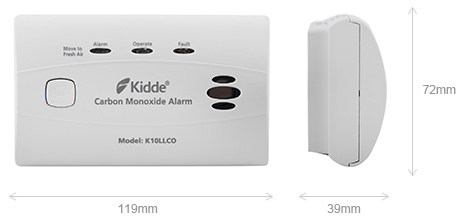10 Year Longlife Battery Carbon Monoxide Detector - Kidde 10LLCO
Providing 10 years of protection against dangerous carbon monoxide gas, the Kidde 10LLCO carbon monoxide alarm features a sealed longlife lithium battery and a 10 year sensor life. Without the need to change batteries, the Kidde 10LLCO provides constant monitoring of CO levels in your home, and will provide an end of life warning when the alarm needs to be replaced. Supplied with a 10 year manufacturer's warranty for peace of mind.
- For homes, and rooms where an open fire or gas appliance is present
- Product Life: 10 years
- Battery: 10 year longlife battery (sealed lithium)
- Warranty: 10 year warranty
- Designed for wall mounting or free-standing installations (plate and fixings supplied)
- Detector alarms from 50ppm (parts per million) of CO gas
- Clear LED status indicators display alarm and power condition
- Combined Test / Reset button facility for easy maintenance
- Sounds a loud 85dB when CO is detected
- Provides end of life warning when the alarm needs to be replaced
- Red LED alarm memory feature - indicates when a CO event has occurred
- Kitemarked to BS EN 50291-1: 2018 and CE marked (for domestic use)
- Dimensions (HxWxD): 72 x 119 x 39mm
- This alarm is also suitable for both the Welsh and Scottish updated 2022 legislation
| Product Code | KE10LLCO |
|---|---|
| Alternative Product Codes | KEK10LLCO, K10LLCO |
| Brand | Kidde |
| Battery Type | 10 Year Sealed Lithium |
| Dimensions (HxWxD) | 72 x 119 x 39mm |
| Display | LED Indicators - Alarm / Operate / Fault |
| Operating Temperature | -10°C to +40°C |
| Relative Humidity | Up to 90% (non-condensing) |
| Sensitivity | 40ppm (parts per million) CO gas |
| Sound Output | 85dB |
| Storage and Transport | -20°C to +60°C, 5% to 90% (non-condensing) |
| Warranty | 10 years |
| Weight | 0.13kg |
| Product Datasheets |
In short: yes, but there isn't just one, single rule to follow.
Legislative requirements for carbon monoxide alarms vary by which country of the UK your house is in and whether it is rented or owner-occupied. Most legislation requires at least one carbon monoxide alarm is fitted near new or replacement fuel-burning appliances (e.g. boiler, oven, fire place), specifically either 'tamper-proof' / 'sealed for life' alarms such as those using lithium batteries, or alternatively mains-powered models which are directly wired into mains supply as opposed to plug-in types. Some countries have exceptions for fuel-burning appliances used solely for cooking. Rented properties mostly require a CO alarm immediately even if no appliances are being installed or replaced.
Please see our page on carbon monoxide alarm legislation for more specific guidance, links to relevant legislation & government guidance, and links to carbon monoxide alarms suitable for each. Alternatively, please view our full range of carbon monoxide alarms if you already know what type you need.
Key Product Features
What's Included?
Every Kidde KE10LLCO is supplied with the following components.
- 1 x Kidde K10LLCO carbon monoxide alarm
- 1 x Wall mounting backplate
- 1 x Screw set (screws & rawl plugs)
- 1 x Instruction manual

Pricing & Availability
| Model | Stock | 1 unit | 2+ units | 5+ units |
|---|---|---|---|---|
| Product Code: KE10LLCO |
Stock Level:
More than 20 in stock Expected dispatch: Today
|
1 unit
£21.60 inc VAT £18.00 ex VAT |
2+ units
£20.40 inc VAT £17.00 ex VAT |
5+ units
£18.28 inc VAT £15.23 ex VAT |
Approved Partner
Delivery Options
The following delivery options are available on this product.
Customer Reviews
85 customers have given this product an overall rating of 4.7 out of 5
Reviews by real customers
All of our product reviews are written by real customers that have purchased this product from us and are published without modification.Rating: 5 / 5 Stars
Reviewed by: J K
Very pleased with the quality of the product
Published on: 14th February 2024
Rating: 5 / 5 Stars
Reviewed by: K J
Very happy with my Choi of carbon monoxide detector.
Published on: 2nd September 2023
Rating: 5 / 5 Stars
Reviewed by: S L
Working well and inspiring confidence.
Published on: 7th July 2023
Looking for more information?
If you have any questions or would like more information about this product you can ask one of our specialists.
Live Chat Available Now











